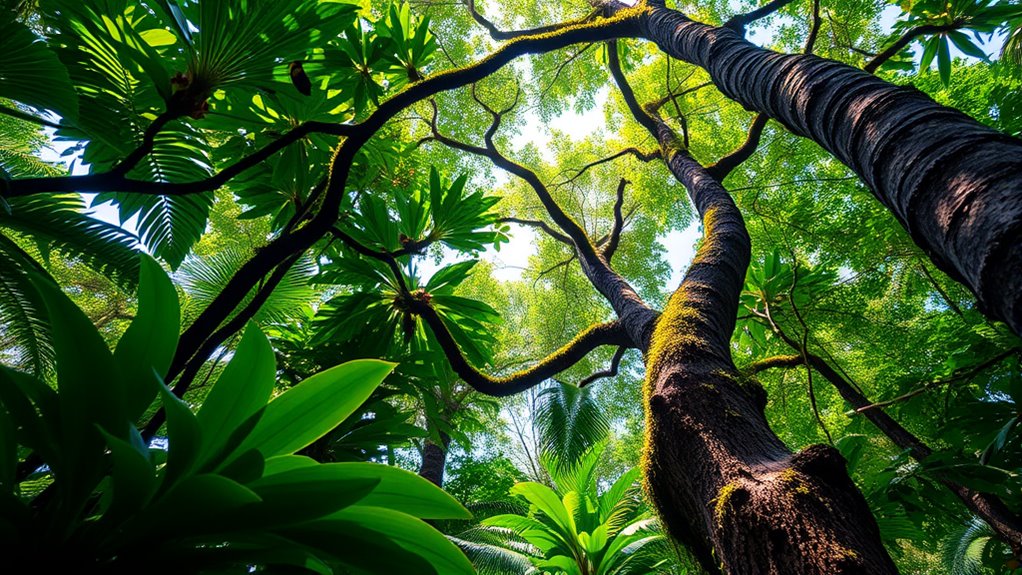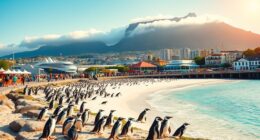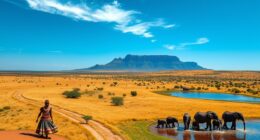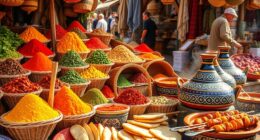Brazil’s Atlantic Forest once spanned over a million square kilometers, but now only about 15% of its original biodiversity remains due to deforestation and habitat fragmentation. This loss has pushed many species toward extinction, disrupted ecosystems, and reduced essential services like pollination and climate regulation. Despite ongoing conservation efforts, much of the forest’s rich variety has vanished. To discover how conservation is helping and what more can be done, keep exploring this important topic.
Key Takeaways
- Only about 15% of Brazil’s Atlantic Forest remains intact today.
- Remaining forest fragments harbor over 20,000 plant species and countless animals.
- Many species are critically endangered due to habitat loss and fragmentation.
- Conservation efforts aim to restore and connect remaining habitats to preserve biodiversity.
- The forest is still a vital reservoir of global biodiversity and ecological functions.
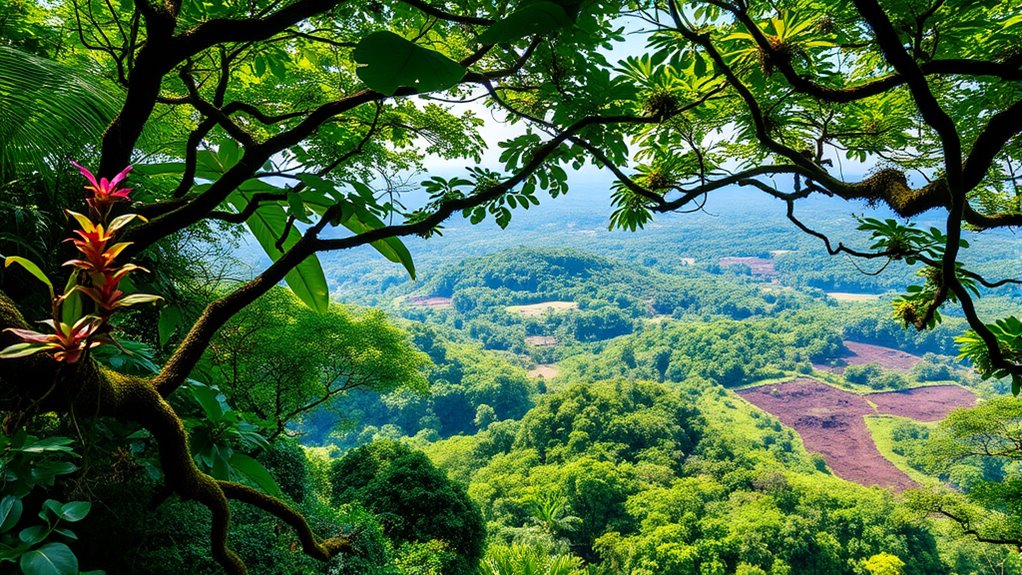
Have you ever wondered what makes Brazil’s Atlantic Forest so essential? This lush, vibrant ecosystem is one of the most diverse habitats on Earth, home to countless species of plants, animals, and fungi. But despite its importance, the Atlantic Forest has faced relentless threats, primarily from deforestation. The impact of clearing land for agriculture, urban development, and logging has drastically reduced its size. Today, only about 15% of the original forest remains, and much of what’s left is fragmented and degraded. This deforestation impact has caused many species to teeter on the brink of extinction, as their habitats shrink and become isolated. You might not realize it, but every tree cut down and every patch of forest cleared diminishes the rich biodiversity that once thrived here. The loss of habitat affects not only individual species but also the overall health of the entire ecosystem, disrupting food chains, pollination, and climate regulation. Protecting remaining forest patches and restoring connectivity are essential conservation strategies to sustain biodiversity. Thankfully, conservation efforts are underway to stem this alarming decline. Brazil and international organizations have launched initiatives aimed at protecting what remains of the Atlantic Forest. These efforts include establishing protected areas, restoring degraded lands, and promoting sustainable land-use practices. You can support these initiatives by advocating for policies that prioritize forest preservation or by choosing products that are responsibly sourced. Conservation isn’t just about setting aside land; it involves actively managing and restoring ecosystems to guarantee their resilience. Community involvement plays a crucial role, as local populations often depend on the forest for their livelihoods. Educating communities about the importance of biodiversity and sustainable practices helps create a shared responsibility for conservation.
While the challenges are significant, hope exists in the form of ongoing projects and renewed awareness. Scientists and conservationists are working tirelessly to catalog remaining species, restore habitats, and establish corridors that reconnect fragmented forests. These corridors help animals migrate and reproduce, which is vital for maintaining genetic diversity. The fight to preserve Brazil’s Atlantic Forest is a continuous process, requiring global cooperation and local commitment. Every effort counts in safeguarding this irreplaceable treasure of biodiversity. If you understand the importance of the Atlantic Forest, you recognize that protecting it isn’t just about saving trees—it’s about securing the future of countless species and the health of our planet. By supporting conservation efforts and being mindful of deforestation impacts, you can contribute to the ongoing battle to preserve one of the world’s most vital ecosystems.
Frequently Asked Questions
What Specific Species Are Critically Endangered in the Atlantic Forest?
You should know that several species in the Atlantic Forest are critically endangered due to habitat fragmentation and ongoing threats. For example, the northern muriqui, a type of primate, faces severe risks, as do the maned wolf and the Brazilian merganser. These species highlight the urgent need for species conservation efforts. Protecting their habitats and addressing fragmentation are essential steps to guarantee their survival and maintain biodiversity in this crucial ecosystem.
How Does Climate Change Impact the Forest’s Biodiversity?
Imagine your world shrinking faster than you can blink—that’s what climate change does to biodiversity. You see, climate effects like rising temperatures and unpredictable rainfall drive species to extinction, causing biodiversity loss. In the Atlantic Forest, this disrupts delicate ecosystems, threatening countless plants and animals. You can help by supporting conservation efforts, but the reality is, if climate effects continue unchecked, the forest’s rich diversity might vanish forever, taking your natural wonder with it.
Are There Successful Conservation Programs Restoring the Forest?
You’ll find that successful conservation programs, like restoration projects, actively restore biodiversity in the Atlantic Forest. These efforts often involve community involvement, which guarantees local people support and sustain the projects. By working together, these programs replant native trees, protect wildlife, and improve ecosystems. Your participation can make a difference, helping to rebuild this essential habitat and preserve its incredible biodiversity for future generations.
What Role Do Local Communities Play in Forest Preservation?
Imagine a vibrant tapestry woven with community involvement and sustainable practices, where your efforts help preserve nature’s delicate balance. You play an essential role in forest preservation by supporting local initiatives and encouraging eco-friendly methods. When communities embrace conservation, they create a ripple effect, protecting biodiversity and fostering resilience. Your participation guarantees the forest’s future, nurturing a harmonious relationship between people and nature that benefits all.
How Much of the Original Atlantic Forest Remains Today?
You might wonder how much of the original Atlantic Forest still exists today. Sadly, deforestation impact and forest fragmentation have drastically reduced it, leaving only about 12-15% of the original area. This loss threatens biodiversity and disrupts ecosystems. You can help by supporting conservation efforts and sustainable practices, ensuring some of this essential habitat survives for future generations. Every action counts in protecting what remains of this precious rainforest.
Conclusion
You see the Atlantic Forest’s beauty, you feel its fragility, and you understand its importance. You realize that protecting its biodiversity means preserving its trees, its animals, and its future. You can act, you can advocate, and you can make a difference. Because when you choose to care, you choose to sustain, to restore, and to honor. The Atlantic Forest depends on you, just as you depend on its richness for generations to come.

